Given the right conditions winter running in the mountains of Scotland can offer some incredibly memorable adventures. However, winter running conditions may also be encountered on a standard training run in much lower hills at any time over the winter season.
The nature of our winter environment means that our margin for safety is extremely narrow, so if we want to continue running in these conditions, careful planning and good decision making is essential. It is important to consider that experienced runners have died of exposure in the UK hills.
Snow that is too soft and snow that is too hard are both problems for us as runners, like Goldilocks we are waiting for it to be ‘just right’ in that narrow window between. When you also add in factors of visibility and wind speed, the number of days that are really suitable for running in the high mountains of Scotland in full winter conditions are few and far between.
To make the most of your days out, be prepared to choose lower objectives and equip yourself fully for the conditions on the day, even if that means slowing to a walk and equipping yourself appropriately with winter boots, walking crampons, an axe (all available to hire at a reasonable price) and a much heavier bag. Think of it as cross training, you’ll gain some great strength endurance!
Enjoying the winter mountains safely demands a much greater knowledge and skill base than summer. Take time to slow down and skill up with a comprehensive winter skills course before you find yourself out of your depth.
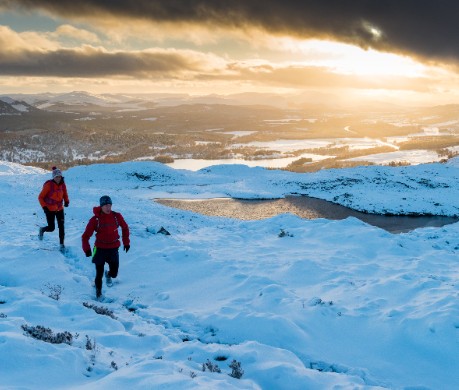
Credit: Ed Smith Photography
Obviously, the weather is going to have a huge impact on any activity we do throughout the winter. Make sure the forecast you are looking at is relevant to the altitude you are intending to visit.
Windy and wet conditions will make the greatest difference to the temperature. Make sure you plan for the 'feels like' temperature on the forecast.
From the forecast you should also consider what visibility will be like and what affect that will have on your ability to navigate (more on navigation below).
Following the forecast over several day or even weeks is important for predicting what snow conditions you will find on your route, unless you are travelling to one of the areas covered by the Scottish Avalanche Information Service.
Careful planning before you head out is essential. It is hard to judge conditions up high just by looking from the carpark. Very often conditions may seem innocuous at the bottom but can be severe at the summit.
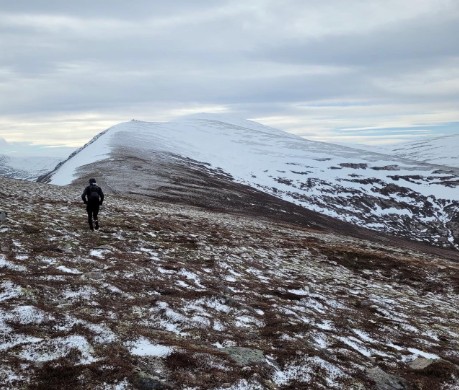
Credit: Trail Running Scotland
Every winter people die of hypothermia in the Scottish mountains.
As runners we want to limit the weight of what we carry, but it is essential that we do this without compromising our safety. Our minimum kit for any run should be enough to keep us alive if we have to stop mid-run and sit down while we wait for help which, in the high mountains during winter, could mean waiting for up to six hours.
This video shows the minimum equipment for summer/autumn conditions, which includes:
In winter additional kit could include:
Even a route that you know well in lowland hills can become unrecognisable with a dusting of snow and poor visibility, so plan ahead and make sure you are equipped to navigate efficiently.
In higher mountains, if navigation becomes challenging, you are likely to move much slower meaning that you will get cold quickly. Be realistic about your navigation skills and choose a route that you will be able to manage.
Plotting a route on your watch or phone can help, but remember that your phone screen may be useless with cold wet hands or big gloves on and the battery can be drained quickly in cold conditions. With this in mind, Mountaineering Scotland have created #SmartNav guidance, to keep your phone working for you when you're in the hills.
Plans may also change, the weather may close in, heavy rain might mean that a burn won't be crossable, or there may be an accident. All such eventualities can’t be pre-programmed into a GPS, so learning the skills to be able to look at the map and understand it – whether on paper or a screen – will mean you can work out the best way to adjust any route to deal with changing situations.
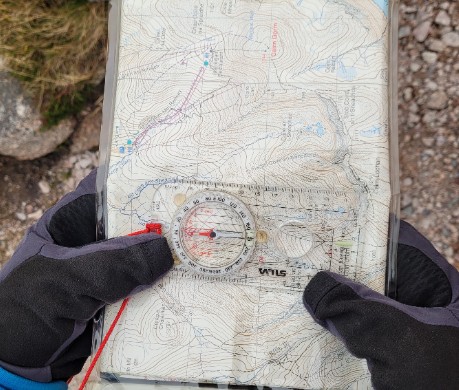
Credit: Ben Gibson
With short daylight hours and many factors that might affect our speed on the hills, it's important to make sure we have a headtorch that is fully charged and locked, as well as spare.
Problems for runners - Too much snow
The Scottish Avalanche Information Service (SAIS) publishes daily forecasts of the snow and avalanche conditions for six mountain areas of Scotland during the winter. The season generally starts in mid-December and goes through to early April, depending on snow cover.
Alongside the avalanche forecast, each area forecaster also posts a daily blog with photos attached providing additional important information to add to your planning – well worth a look at.
Use the ‘Be Avalanche Aware’ process to understand and avoid avalanche dangers in the hills.
The additional consideration on snow conditions is how it will affect our moving speed. Deep snow is slow, and hard work to move through. This will affect the timings for your day, but also may mean that you aren’t able to keep warm as easily.
Problems for runners - Hard snow
After a thaw and refreeze, any snow on the hills will be hard and icy. Even when crossing small areas of snow the use of crampons and ice axe are essential.
Micro spikes or Yak tracks are limited in their effectiveness in these conditions and can fail on steeper slopes leading to dangerous falls.
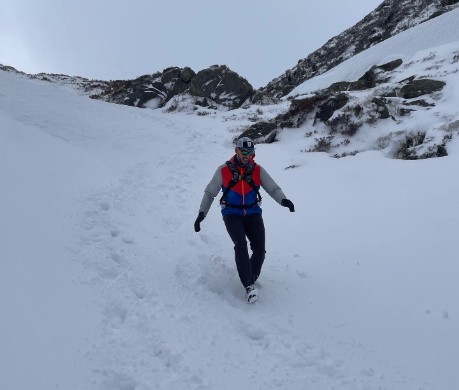
Credit: Trail Running Scotland
Microspikes and Yaktracks
These are small 3-4mm studs, or coils of wire, that attach to any shoe by a rubber cradle. They are designed to be used on icy pavements and flat trails. They are great in these conditions but are insufficient to prevent a slip on angled ice or hard snow.
Note, the manufactures don’t call these running crampons. These have 8mm spikes on a chain and will give more purchase on moderate angled slopes. They do, however have a limit. They will not mange with the same conditions that a waking crampon on a stiff boot can handle. As they have no front points, they can only be used flat-footing, so are really not suitable for steeper slopes. There is also potential with some designs to roll off your shoe when flat footing on hard angled slopes. Get to know the limitations of your equipment in a safe area before trying it on more consequential terrain.
On any slope, consider what the consequence of a slip would be. This will be affected by snow conditions but also terrain. Careful route planning and awareness on the hill will show you areas of "no fall terrain" where a slide would take you over steep slopes or edges.
An ice axe may mitigate against a fall, but is no guarantee. Is the equipment you are using sufficient to keep you safe?
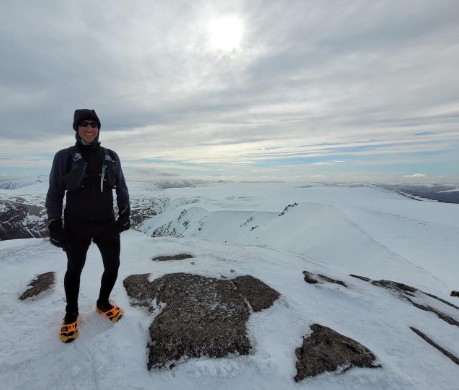
Credit: Trail Running Scotland
With so many variables to consider, even the most carefully planned day out might not go exactly as you anticipated. Rather than waiting until this happens and improvising on the hill, be proactive and have a plan B, C or D in mind before you leave the house. Understand where your options are for changing a day and be prepared to turn around or shorten your day before you find yourself in trouble.
This page has been created in association with: